Characteristic Analysis of DFIG Wind Turbine under Blade Mass Imbalance Fault in View of Wind Speed Spatiotemporal Distribution
Abstract
:1. Introduction
2. DFIG WTs Model and Blade Mass Imbalance Model
2.1. The Rotor Torque when Blade Mass Imbalance
2.2. The Electromagnetic Power when Blade Mass Imbalance
3. Influence of Wind Shear and Tower Shadow Effect on Electromagnetic Power
4. Simulation Results and Analysis
4.1. Simulation Model and Parameters
4.2. Fault Diagnosis Step
- Step1. The electromagnetic torque and electromagnetic power under blade mass imbalance condition were measured, and then spectrum analysis on the signal by FFT was performed to obtain the characteristic frequency and its amplitude as the reference value;
- Step2. Electromagnetic torque and electromagnetic power were measured under the equivalent wind speed condition, blade mass imbalance condition, and then spectrum analysis was performed on the signal by FFT to obtain the characteristic frequency and its amplitude;
- Step3. Comparing the amplitude of the characteristic frequency when the signal only exists, the blade mass imbalance diagnosis, the amplitude of the characteristic frequency of the signal at the imbalance condition under the equivalent wind speed, and the fault characteristics and frequency were obtained;
- Step4. By comparing with the theoretical derivation results, the correctness of the conclusion in Section 3 was verified, and the fault characteristics summarized.
4.3. Fault Simulation Analysis
5. Conclusions
- (1)
- The blade mass imbalance of the DFIG will cause fluctuations in the output torque of the wind rotor. The presence of wind shear and tower shadow effect will also cause fluctuations in the output torque and will pass through the transmission chain reflect in electromagnetic torque and electromagnetic power. So it is feasible to use an electrical signal to detect the fault.
- (2)
- Considering only the blade mass imbalance under the average wind speed at the hub will cause the electromagnetic torque and electromagnetic power to fluctuate at the 1P frequency.
- (3)
- Considering the spatiotemporal distribution of wind speed and the influence of wind shear and tower shadow effect, the blade mass imbalance fault will cause fluctuation at the frequency of 1P, 3P, and 6P on electromagnetic power, in which the fluctuation at 1P is caused by the mass imbalance fault while the fluctuation at 3P and 6P are caused by wind shear and tower shadow effect; the amplitude of the fluctuation at 1P is proportional to the degree of the imbalance fault.
Author Contributions
Funding
Conflicts of Interest
Abbreviations
| b | Imbalance coefficient |
| Bs | Damping coefficient |
| Cp (σ, λ) | Rotor power coefficient |
| DFIG | Doubly-fed induction generator |
| f1 | Stator output rotational frequency |
| Fi | Centrifugal force of each blade |
| Gi | Gravity force of each blade |
| ird | d axis components of the rotor current |
| irq | q axis components of the rotor current |
| isd | d axis components of the stator current |
| isq | q axis components of the stator current |
| Jw | Rotational inertia of the turbine |
| Je | Rotational inertia the generator respectively |
| Ks | Equivalent stiffness coefficient of the transmission chain |
| Lm | Mutual inductance |
| mi | Mass of the equivalent mass block |
| np | Pairs of poles |
| nω | Rotational speed |
| Pe | Electromagnetic power |
| ri | The distance between equivalent mass block to the hub center |
| R | Rotor radius |
| Te | Electromagnetic torque of the generator |
| Tw | Aerodynamic torque of the rotor |
| Torque of the rotor | |
| Veq | Equivalent wind speed |
| VH | Wind speed |
| Vts | Tower shadow effect component |
| Vws | Wind shear component |
| WT | Wind turbine |
| ωe | Rotational speed of the generator |
| ωw | Rotor angular velocity |
| λ | Tip-speed ratio |
| σ | Blade pitch angle |
| ρ | Air density |
| ϕ | Initial position angle of the blade |
| θs | Angle of torsion of the drive shaft |
References
- Cai, X.; Pan, P.; Zhu, J.; Gu, R.R. Blade of Wind Wurbines; China Water Power Press: Beijing, China, 2014. [Google Scholar]
- Rabanal, A.; Ulazia, A.; Ibarra-Berastegi, G.; Sáenz, J.; Elosegui, U. MIDAS: A Benchmarking Multi-Criteria Method for the Identification of Defective Anemometers in Wind Farms. Energies 2018, 12, 28. [Google Scholar] [CrossRef]
- Astolfi, D. A Study of the Impact of Pitch Misalignment on Wind Turbine Performance. Machines 2019, 7, 8. [Google Scholar] [CrossRef]
- Elosegui, U.; Egana, I.; Ulazia, A.; Ibarra-Berastegi, G. Pitch Angle Misalignment Correction Based on Benchmarking and Laser Scanner Measurement in Wind Farms. Energies 2018, 11, 3357. [Google Scholar] [CrossRef]
- Astolfi, D. Castellani Francesco. Wind Turbine Power Curve Upgrades: Part II. Energies 2019, 12, 1503. [Google Scholar] [CrossRef]
- Ramlau, R.; Niebsch, J. Imbalance Estimation without Test Asses for Wind Turbines. J. Sol. Energy Eng. 2009, 131, 011010. [Google Scholar] [CrossRef]
- Jiang, D.; Huang, Q.; Hong, L. Theoretical and Experimental Study on Wind Wheel Imbalance for a Wind Turbine. In Proceedings of the World Non-Grid-Connected Wind Power and Energy Conference, Nanjing, China, 24–26 September 2009; pp. 351–355. [Google Scholar]
- Zhao, M.; Jiang, D.; Li, S. Research on Fault Mechanism of Icing of Wind Turbine Blades. In Proceedings of the World Non-Grid-Connected Wind Power and Energy Conference, Nanjing, China, 24–26 September 2009; pp. 356–359. [Google Scholar]
- Gong, X.; Qiao, W. Simulation Investigation of Wind Turbine Imbalance Faults. In Proceedings of the International Conference on Power System Technology, Hangzhou, China, 24–28 October 2010; pp. 1–7. [Google Scholar]
- Caselitz, P.; Giebhardt, J. Rotor Condition Monitoring for Improved Operational Safety of Offshore Wind Energy Converters. J. Sol. Energy Eng. 2005, 127, 253–261. [Google Scholar] [CrossRef]
- Yang, T.; Ren, Y.; Liu, X.; Huang, S.; Gao, W. Research on the Modeling and Simulation of Wind Turbine Rotor Imbalance Fault. J. Mech.Eng. 2012, 48, 130–135. [Google Scholar] [CrossRef]
- Xiang, G.; Wei, Q. Imbalance Fault Detection of Direct-drive Wind Turbines Using Generator Current Signals. IEEE Tran. Energy Convers. 2012, 27, 468–476. [Google Scholar]
- Hang, J.; Zhang, J.Z.; Cheng, M.; Zhu, Y.; Zhang, B.F. Fault Diagnosis of Blade Imbalance and Winding Asymmetry of Direct-driven Wind Turbine with Permanent Magnet Synchronous Generator. Proc. CSEE 2014, 34, 1384–1391. [Google Scholar]
- Deng, X.; Pan, Q.; Gao, Q. Research on the Modeling and Simulation of Permanent Magnet Direct-driven Wind Turbine Rotor Imbalance Fault. Power Syst. Prot. Control 2018, 46, 35–40. [Google Scholar]
- Sheng, X.; Wan, S.; Li, Y.; Cheng, L. Characteristic Analysis of Doubly-Fed Induction Generator under Blade Mass Imbalance Fault. Acta Energy Sol. Sin. 2017, 38, 1324–1332. [Google Scholar]
- Dolan, D.S.L.; Lehn, P.W. Simulation model of wind turbine 3p torque oscillations due to wind shear and tower shadow(Article). IEEE Trans. Energy Convers. 2006, 21, 717–724. [Google Scholar] [CrossRef]
- Fadaeinedjad, R.; Moschopoulos, G.; Moallem, M. The Impact of Tower Shadow, Taw Error, and Wind Shears on Power Quality in a Wind–diesel System. IEEE Trans. Energy Convers. 2009, 24, 102–111. [Google Scholar] [CrossRef]
- McSwiggan, D.; Littler, T.; Morrow, D.J.; Kennedy, J. A Study of Tower Shadow Effect on Fixed-speed Wind Turbines. In Proceedings of the 43rd International Universities Power Engineering Conference, Padova, Italy, 1–4 September 2008; pp. 1–5. [Google Scholar]
- Wen, B.; Wei, S.; Wei, K.; Yang, W.; Peng, Z.; Chu, F. Influences of Wind Shear and Tower Shadow on the Power Output of Wind Turbine. J. Mech. Eng. 2018, 54, 124–132. [Google Scholar] [CrossRef]
- Slootweg, J.G.; Polinder, H. Dynamic Modeling of a Wind Turbine with Doubly Fed Induction Generator. In Proceedings of the 2001 IEEE Power Engineering Society Summer Meeting, Vancouver, BC, Canada, 15–19 July 2001; pp. 644–649. [Google Scholar]
- Jenny, N.; Ronny, R.; Thien, T.N. Mass and Aerodynamic Imbalance Estimates of Wind Turbines. Energies 2010, 3, 696–710. [Google Scholar] [Green Version]
- Elkinton, M.R.; Rogers, A.L.; McGowan, J.G. An Investigation of Wind-shear Models and Experimental Data Trends for Different Terrains. Wind Eng. 2006, 30, 341–350. [Google Scholar] [CrossRef]
- Rehman, S.; Al-Abbadi, N.M. Wind shear coefficients and their effect on energy production. Energy Convers. Manag. 2005, 46, 2578–2591. [Google Scholar] [CrossRef]
- NWTC Information Portal. Available online: https://nwtc.nrel.gov/FAST (accessed on 3 August 2019).
- Gardels, D.J.; Qiao, W.; Gong, X. Simulation Studies on Imbalance Faults of Wind Turbines. In Proceedings of the 2010 IEEE Power & Energy Society General Meeting, Providence, RI, USA, 25–29 July 2010; pp. 1–5. [Google Scholar]
- He, Y.; Hu, J.; Xu, L. Operation and Control of Grid Doubly-fed Induction Generator; China Electric Power Press: Beijing, China, 2011. [Google Scholar]
- Wan, S.; Cheng, L.; Sheng, X. Numerical Analysis of the Spatial Distribution of Equivalent Wind Speeds inLarge-scale Wind Turbines. J. Mech. Sci. Technol. 2017, 31, 965–974. [Google Scholar] [CrossRef]

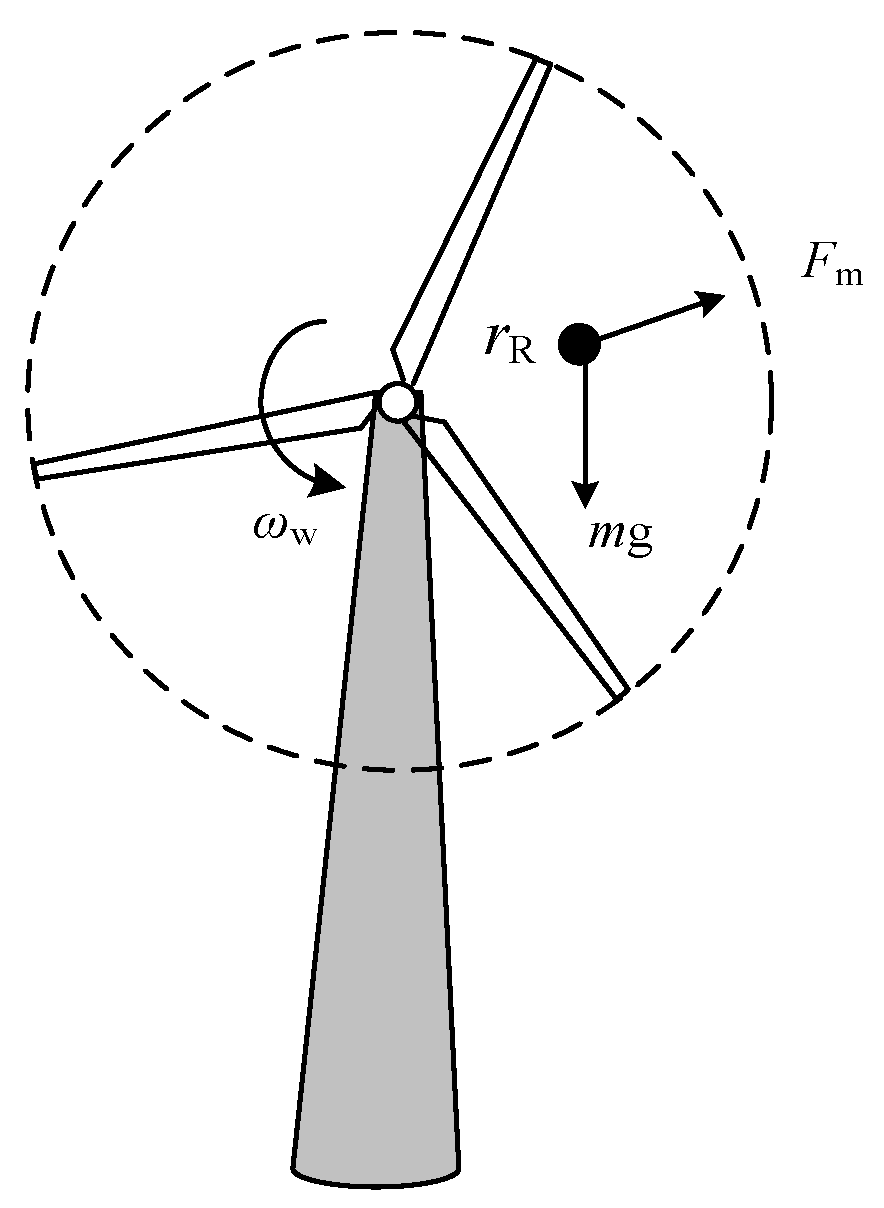


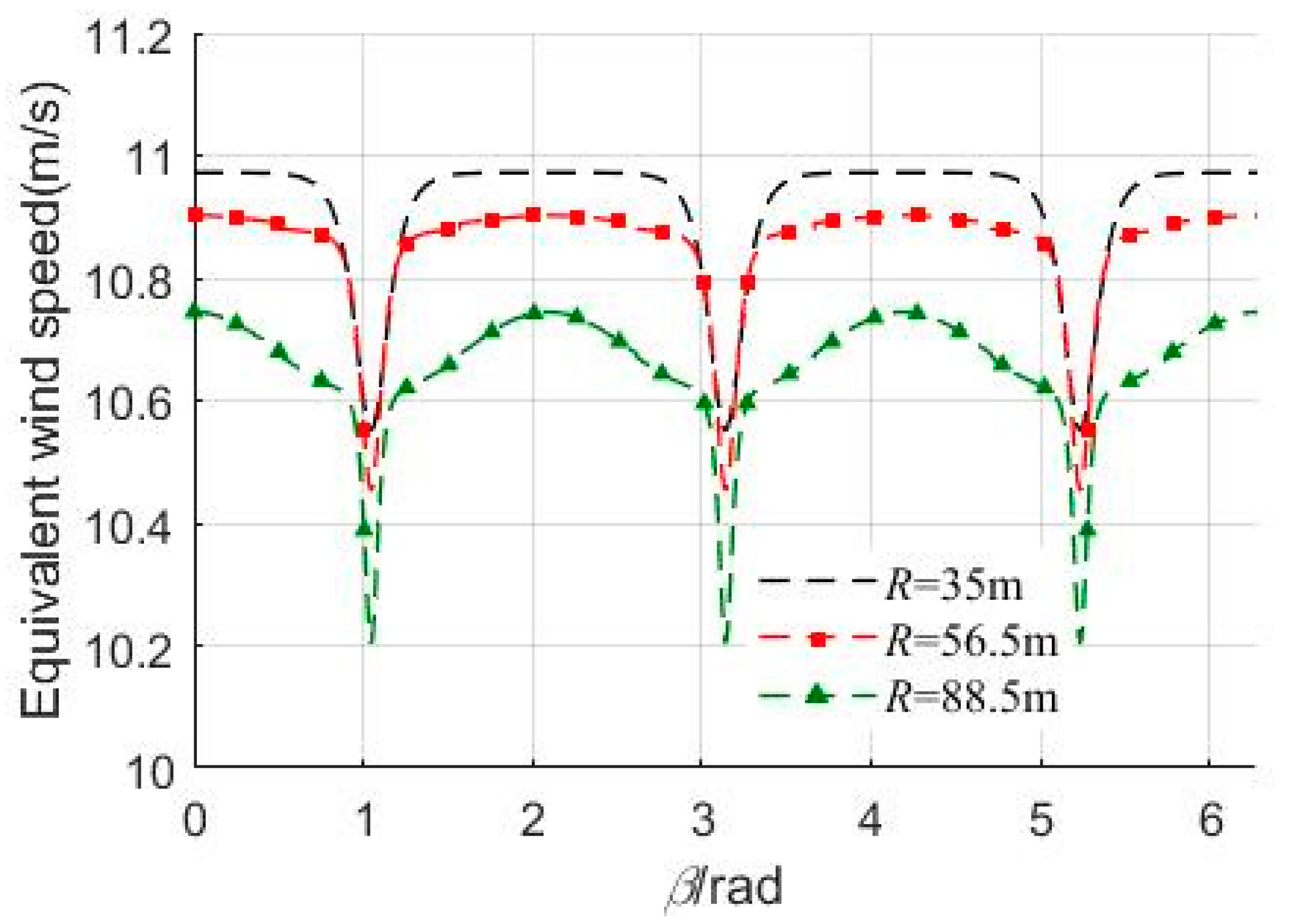




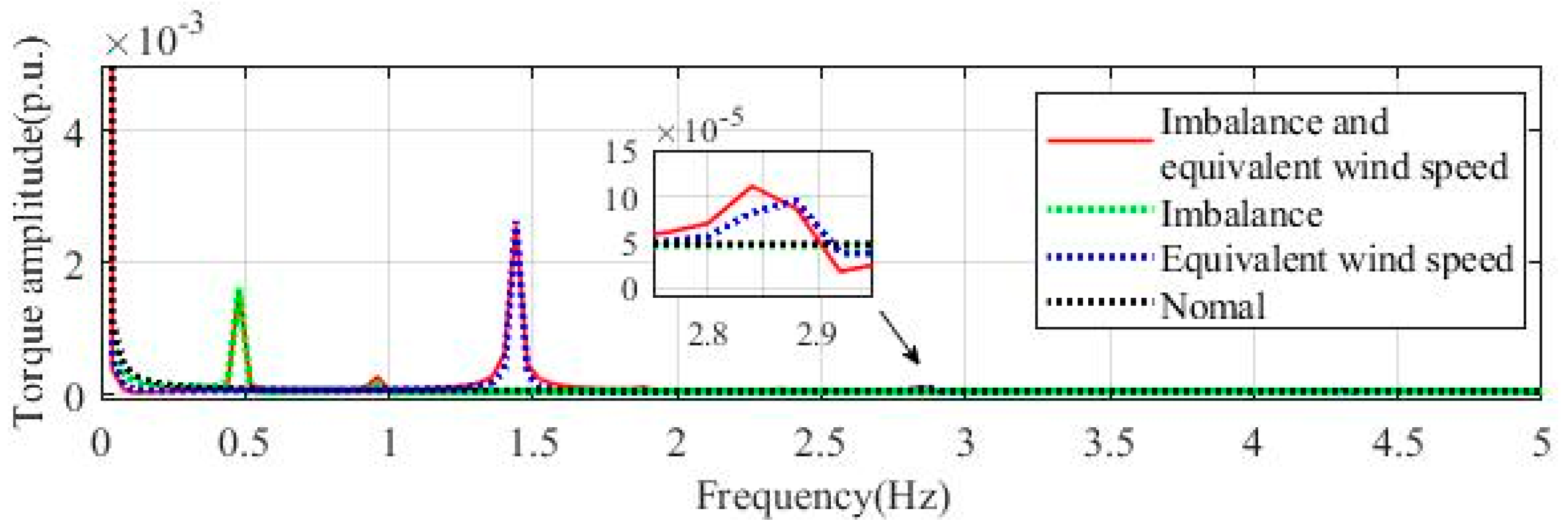

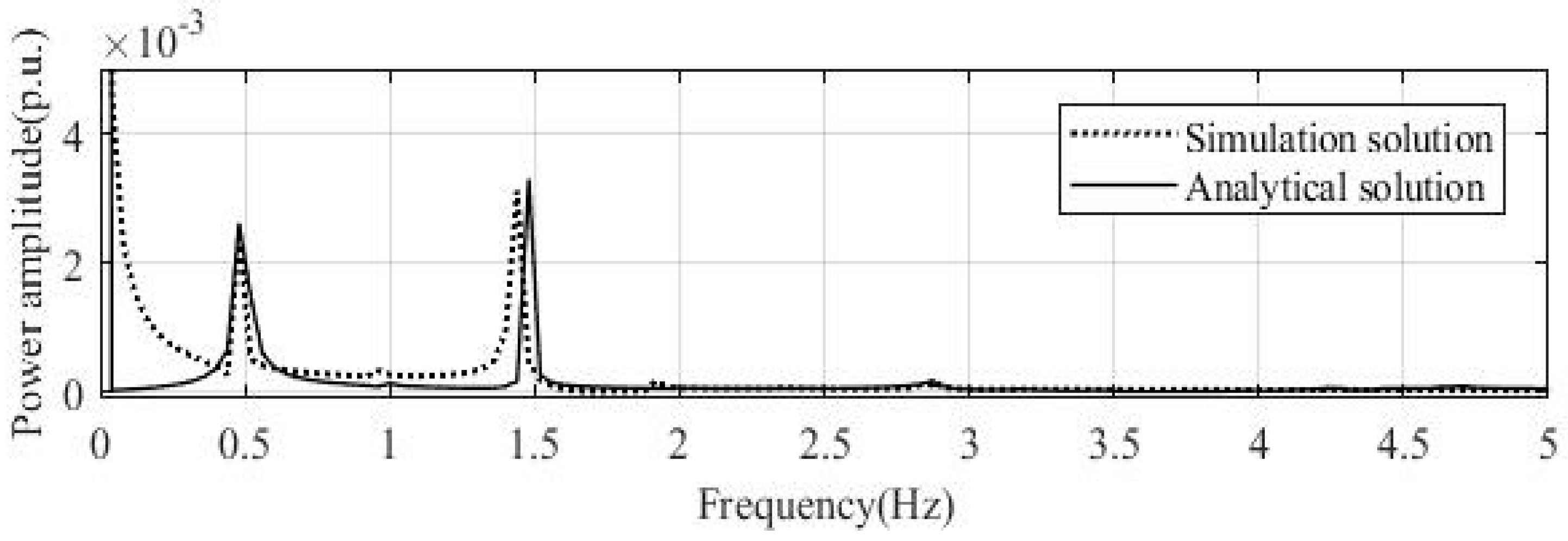

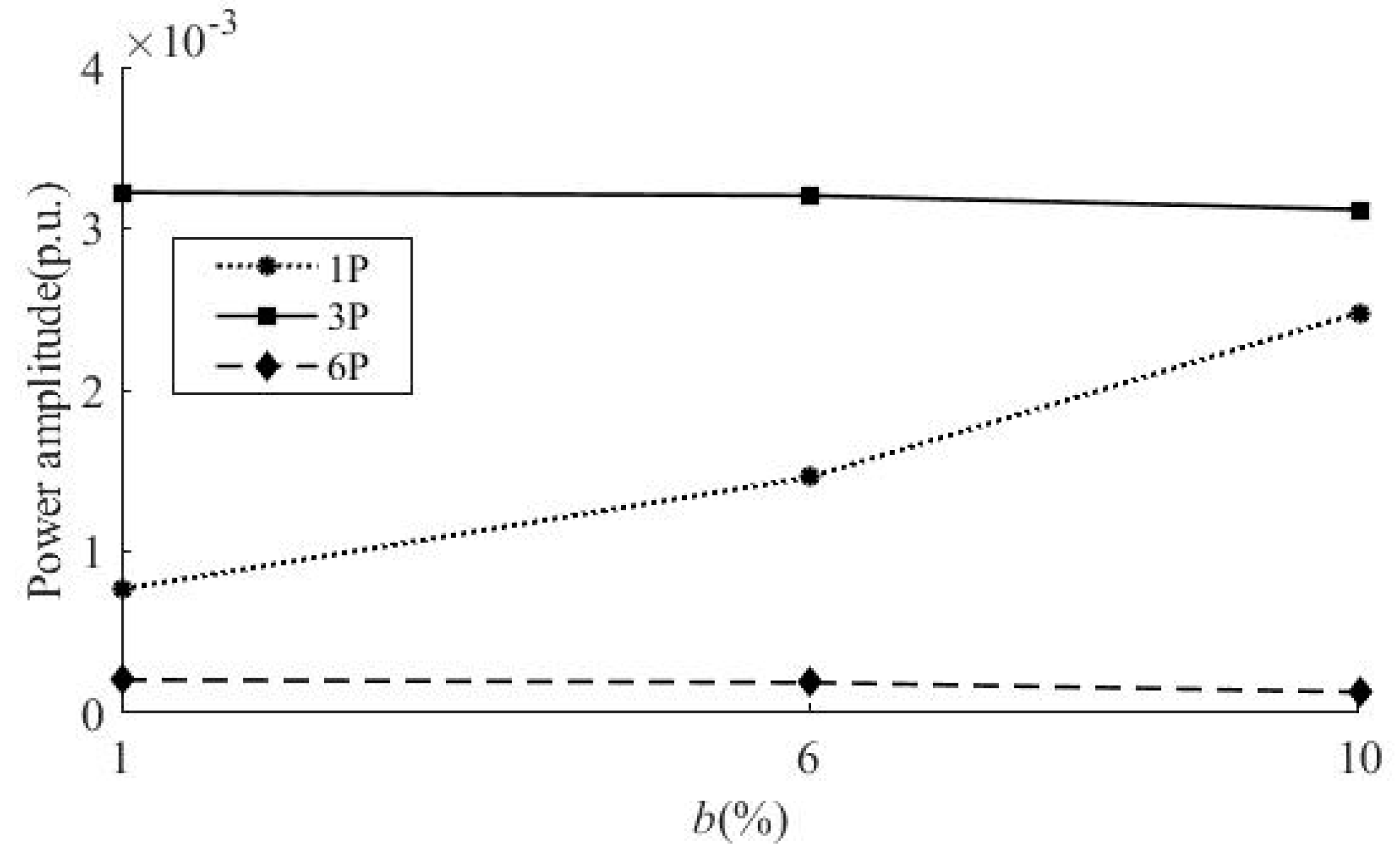
| P (kW) | R (m) | H (m) | A (m) | x (m) |
|---|---|---|---|---|
| 1500 | 35 | 70 | 4.0/2.8 (3.4) | 4.5 |
| 2500 | 56.5 | 87 | 4.6/3.2 (3.9) | 5.2 |
| 8000 | 88.5 | 131 | 6.0/4.0 (5.0) | 7.5 |
| Parameters | Value | Parameters | Value |
|---|---|---|---|
| Rated power (MW) | 1.5 | Stator resistance (p.u.) | 0.023 |
| Rated speed (m/s) | 11 | Stator leakage inductance (p.u.) | 0.18 |
| Optimum tip speed ratio | 8.7 | Rotor resistance (p.u.) | 0.016 |
| Optimum rotor power coefficient | 0.38 | Rotor leakage inductance (p.u.) | 0.16 |
| Blade diameter (m) | 35 | Pairs of poles | 3 |
| Tower diameter (m) | 1.7 | Inertia constant (s) | 0.685 |
| Center height of the hub (m) | 70 | Air density (kg/m3) | 1.225 |
| Imbalance Fault Degrees | Frequency (Hz) | ||
|---|---|---|---|
| 0.48 Hz (f1P) | 1.44 Hz (f3P) | 2.88 Hz (f6P) | |
| 1% | 0.000767 | 0.003222 | 0.000205 |
| 6% | 0.001459 | 0.003203 | 0.000189 |
| 10% | 0.002478 | 0.003116 | 0.000130 |
© 2019 by the authors. Licensee MDPI, Basel, Switzerland. This article is an open access article distributed under the terms and conditions of the Creative Commons Attribution (CC BY) license (http://creativecommons.org/licenses/by/4.0/).
Share and Cite
Wan, S.; Cheng, K.; Sheng, X.; Wang, X. Characteristic Analysis of DFIG Wind Turbine under Blade Mass Imbalance Fault in View of Wind Speed Spatiotemporal Distribution. Energies 2019, 12, 3178. https://doi.org/10.3390/en12163178
Wan S, Cheng K, Sheng X, Wang X. Characteristic Analysis of DFIG Wind Turbine under Blade Mass Imbalance Fault in View of Wind Speed Spatiotemporal Distribution. Energies. 2019; 12(16):3178. https://doi.org/10.3390/en12163178
Chicago/Turabian StyleWan, Shuting, Kanru Cheng, Xiaoling Sheng, and Xuan Wang. 2019. "Characteristic Analysis of DFIG Wind Turbine under Blade Mass Imbalance Fault in View of Wind Speed Spatiotemporal Distribution" Energies 12, no. 16: 3178. https://doi.org/10.3390/en12163178





